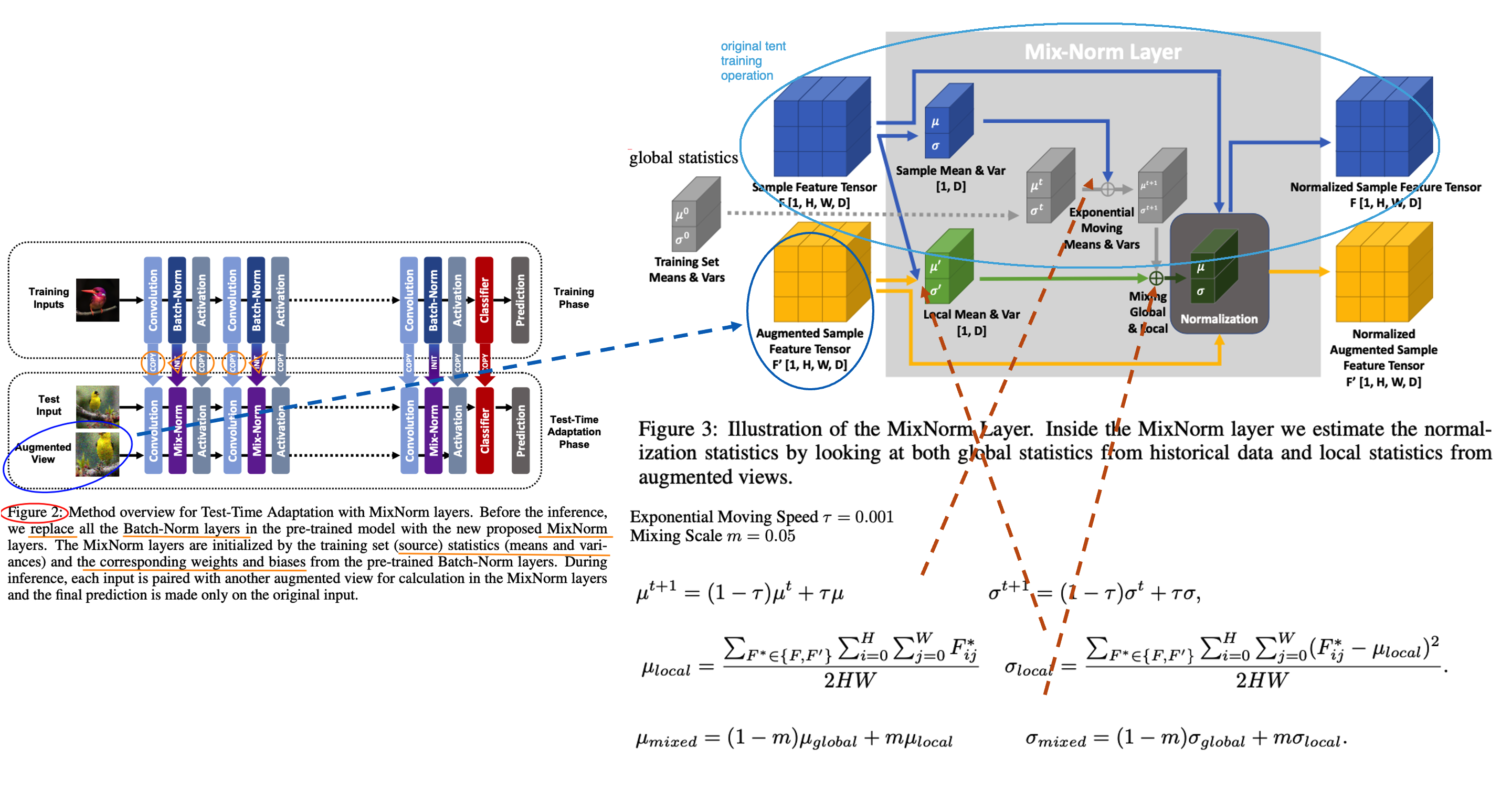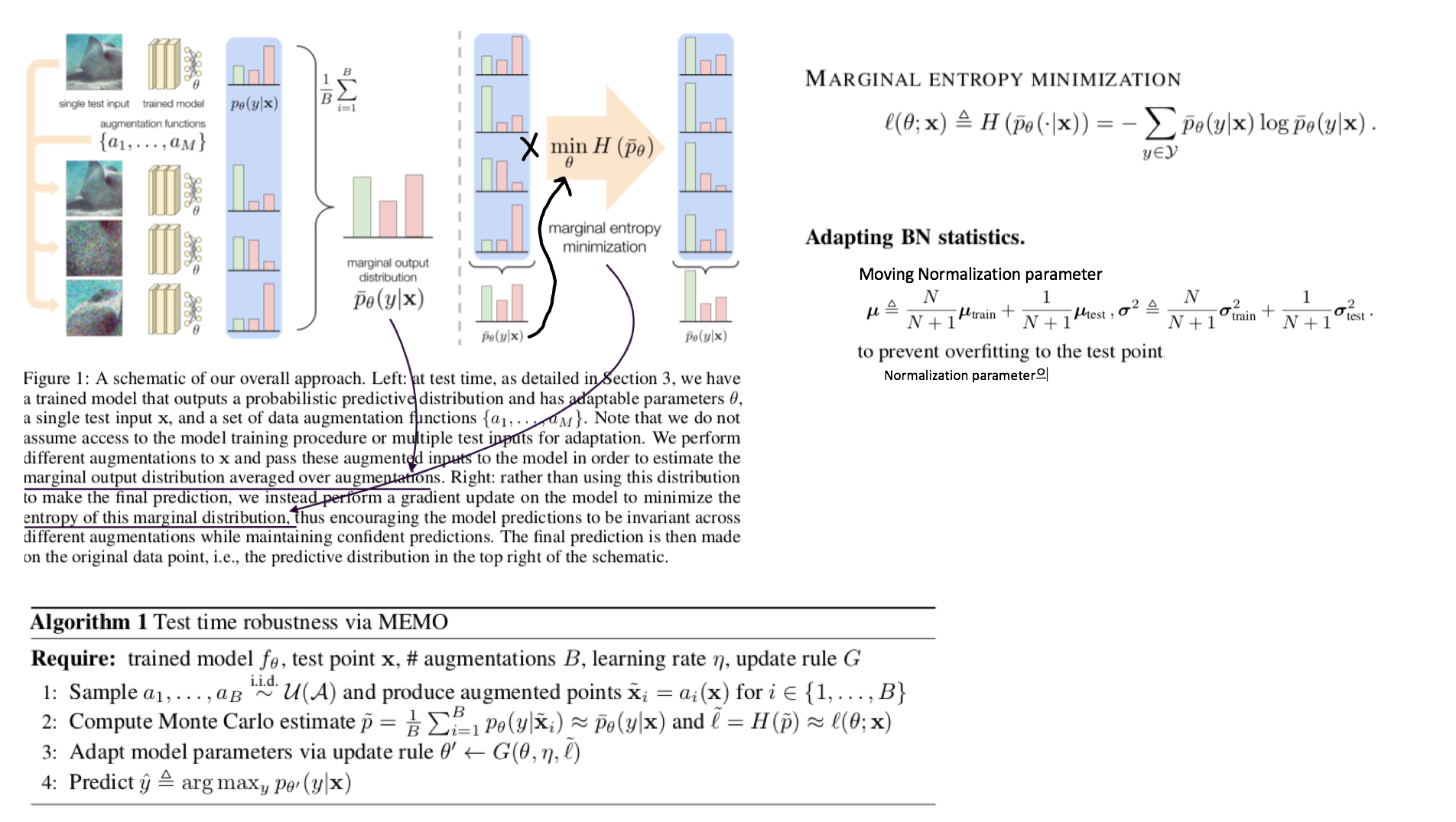- DG survey - TENT 관련 논문을 읽고 **High Level**에 대한 이해 & 정리 - **각 논문에서 집중해야할 사항:** TTA에서 무엇을 개선한건가? 어디를 본건가? TTA에서 어떤 점이 아쉬워서 깊게 Following 했는가? Setting과 Method가 무엇인가? 무엇이 문제라고 생각하여 어디를 건들였는가? **High Level 정리** 1. (#7.1) Instance Adaptive Self-Training for Unsupervised Domain Adaptation (IAST) 2. (#7.2) Test-Time Personalization with a Transformer for Human Pose Estimation 3. (#7.3) Pixel-Level Cycle Association: A New Perspective for Domain Adaptive Semantic Segmentation 4. (#7.4) Label-Driven Reconstruction for Domain Adaptation in Semantic Segmentation 5. (#7.5) Mixnorm: test-time adaptation through online normalization estimation - Small batch에서 TTA를 해서도, Normalization statistics 을 최적으로 만들 수 있는 Momentun Normalization statistics 방법 제안 - Loss 및 Affine Parameter (α, β)는 TTA에 고려하지 않는다. 6. ## 7.1 Instance Adaptive Self-Training for Unsupervised Domain Adaptation (IAST) 종기 PDF 필기본 참조 ## 7.2 Test-Time Personalization with a Transformer for Human Pose Estimation 종기 PDF 필기본 참조 ## 7.3 Pixel-Level Cycle Association: A New Perspective for Domain Adaptive Semantic Segmentation 종기 PDF 필기본 참조 ## 7.4 Label-Driven Reconstruction for Domain Adaptation in Semantic Segmentation 종기 PDF 필기본 참조 # 7.5 Mixnorm: test-time adaptation through online normalization estimation  Abstract 1. 과거 method들은 large batch를 사용하고 single test distribution을 고려한다. 하지만 이 두 가정은 TTA에서 적절치 못하다. 2. 이 논문의 Method에서는 (1) 적은 batch만으로도 적절한 batch-norm statistics (BN normalization위한 statistics) 을 추정하고, (2) Multi distribution 을 고려한다. 3. 즉, 논문 Setting은 Small batch && Multi target (ImageNet-C) 이다. 4. Loss는 사용하지 않는다. 따라서 Weight, Bias는 Update하지 않는다. Running_stack statistics을 점점 target에 맞추어 바꿔감으로써 Evaluation 성능을 높히는 것을 목적으로 한다. Method 1. Pretrained weight를 가져올 때, 모든 weight들은 copy한 후 (BN statistics + weight/bias까지) BatchNorm은 Mix-Norm-layer 으로 바꾼다. 2. 자세한 method는 위 그림 혹은 논문 참조. 3. 정확히 안 나와 있지만, 이 논문에서는 TENT training /Evaluation operation을 어떻게 다르게 했는지는 이야기 하지 않고 있다. (S4T 처럼) 근데 사실 이게 맞다. Operation을 바꾼다는게 사실 더 웃기다. {Training / Test time Training / Test} 이 중 뒤에 2개는 당연히 operation이 같아야 하지 않을까? 그럼에도 불구하고 나는 Test 단계에서는 running statistics를 고정하고 Test time Training에서는 running statistics 를 Adaptation하는게 "Evaluation (지금까지 학습한게 전혀 다른 dataset에 대해서, 새로 만날 dataset에 대해서 잘 동작할 weight인가? )"이라는 목적에서는 더 그럴듯 한 것 같다. Results 1. [Table1] Moving Speed, Global scale, Local Scale을 바꿔서 Mixed Norm이 얼마아 좋은지 실험하였다. Running_stack statistics을 target feature statistics 그대로 사용하면 가장 성능이 낮다. source tracked statistics을 사용하면 중간 성능이다. source와 target statistics을 적절히 섞어서 Normalization parameter를 최적으로 맞춘게 가장 성능이 좋다. 2. [Table1] 가장 아래 행의 수치가 TENT를 적용해 de-norm parameter를 Update한 결과이다. 성능향상에 큰 의미가 없다. (TENT의 Key가 Normalization parametor인지 / de-norm parametor인지 실험이 필요한 듯 하다.) 3. [Table2] Local Mean/Var를 만들기 위해 몇개의 Augmentation 기법을 사용한지에 따른 성능 변화이다. 많이 한다고 의미없고 1개만 해도 충분히 좋은 성능이 나온다고 한다. 그럴만 하다. 딱 예측에 필요한, 현재 Batch를 위한 Normalization parameter를 만들고 싶다면 사실 augmenation feature 무쓸모다. 4. ( ImageNet-C에 대한 성능 수치를 제시한다. 이게 정말 Multi target (distributions)을 고려했다고 할 수 있는 것인지 모르겠다. ) # 7.6 Test-time batch statistics calibration for covariate shift  Abstract 1. 기존 Method들은 Source의 running_statistics를 Target running_statistics으로 덮어버린다. 이는 target batch statistics (running_track)과 source parameter (CNN weights) 간에 Mismatch를 야기한다. 2. 때문에 (1) α-BN이라는 BN-calibration 기법을 새로 제안한다. (2) Novel loss function으로 Core (the pairewise class correlation online optimization) 기법을 제안한다. 3. 어떤 Training도 하지 않고, α-BN 만 적용해서 {GTA5 -> Cityscape} {28.4% -> 43.9%} 성능 향상을 이뤄냈다. Understanding Test Time Normalization - T-BN (Test-time normalization) 은 항상 free launch를 주지 않는다. 장점 만을 가지고 있지 않다. CNN weight들은 source꺼고 BN normalization연산은 target을 위한 것으로 완전히 대체되다 보니 모델 내부의 Mismatch가 발생할 수 있다. Test-Time Batch statistics calibration - 지금까지 TTA는 Source-statistics를 버리고, Target-statistics를 running tracking 했었다. 이것은 "alleviates domain shift" 장점이 있지만, "perturbs the discriminative structures" 하는 단점을 야기할 수 있다. - 이러한 문제점을 해결하고자 심플하면서 강력한 Method인 α-BN 을 제시한다. Results - 성능 결과는 매우 놀랍다. - Entropy Loss와 같은 Self-loss로 Training하지 않고 α-BN 만 적용한 것 만으로도 5miou성능 향상이 일어난다. - Segmentation 에서는 Core loss 적용 결과는 제시되어 있지 않다. Semantic segmentation을 위한 Core loss가 아니여서 그런 듯 하다. # 7.6 Adaptive generalization for semantic segmentation  Abstract 1. Instance adaptive batch normalization 2. Self-supervised loss for SegTTT (Segmentation Test time training) Method 1. Instance-adaptive batch normalization : 위 α-BN과 비슷하지만, Target normalization parm는 Instance Normalization 값을 사용한다. 그리고 여기서 α는 learnable 하고, Test time 때 training된다. 2. Learning from a single sample : 1. 한 batch를 하나의 이미지와 그 이미지의 augmentation (horizontal flipping, multi-scaling, grayscaling) 으로 구성한다. 2. 한 Batch에서 forward해서 나오는 결과의 전부를 Average해서 Soft-max score를 추출한다. 3. 각 Class를 위한 Threshold를 설정하고 ignore-nonignore mask를 만든다. mask를 적용한 pseudo label 을 만든다. 4. 이 mask를 사용해서 Cross entropy loss를 걸어서 모델을 갱신한다. 이 과정을 Nt번 수행한다. 5. Updated image를 가지고, 위의 같은 이미지를 다시 Inference해서 나오는 결과를 prediction result로 사용한다. 6. (아마 α를 제외하고) 모든 파라미터를 source 로 다시 reset한다. 7. 새로운 이미지가 들어오면 1번부터 6번까지의 과정을 다시 반복한다. Results 1. Instance-adaptive batch normalization에 의한 Miou 성장률은 1 정도 이다. 2. Learning from a single sample 으로 인한 성능 향상은 2 정도 이지만, 정말 말도 안되는 웃긴 학습 전략이다. 따라서 의미없다. # 7.7 Memo: Test time robustness via adaptation and augmentation  Abstract 1. Prior works의 가정: Access to multiple test points (Video 시나리오 처럼 한장의 이미지가 들어오는게 아니라 다른 종류의 이미지가 다수로 들어오는 컨셉) 2. 한장의 이미지와 그 이미지의 Augmentation을 어러게 만들어서 Predict 한다. 나온 결과의 average를 사용해서 Marginal ntropy minimization 하여 Adaptation한다. (그림 확인) 3. Memo = Marginal Entropy Minimization with One test point 4. Ps. Marginal distribution의 의미는? = Augmentation 결과에 대해서 Consistent한 Label을 예측하게 유도하다 보면 기존 Source distribution에 추가적인 (Marginal) distribution 까지 학습할 수 있게 된다. Method 1. \[#7.6\] 논문과 유사하게, Test set 내부의 이미지 각각을 model에 독립적으로 학습시켜서 Inference한다. 한장 Adpataion하고 Infernece하고를 반복한다. 2. Marginal Entropy minimization이라고 함은, 간단하게 Multi augmented Image의 Prediction results 들의 평균을! Entropy Minimization하는 것이다. Results 1. Classification에서 2~3정도의 Error 감소가 존재한다. (그리 큰 감소는 아닌 듯 하다.) # 7.8 If your data distribution shifts, Use self-learning Abstract & Instruction 에서 중요한 이야기 없다. 1. Standard cross-enropy loss / Entropy minimizaion 기법은 label noise에 매우 민감하다. 2. Robust Pseudo-Labeling 기법으로 Generalized Cross Enropy Loss를 사용했다. 